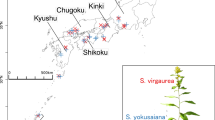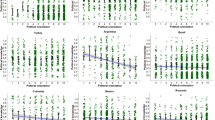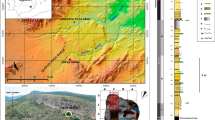Abstract
There is disagreement about whether human political evolution has proceeded through a sequence of incremental increases in complexity, or whether larger, non-sequential increases have occurred. The extent to which societies have decreased in complexity is also unclear. These debates have continued largely in the absence of rigorous, quantitative tests. We evaluated six competing models of political evolution in Austronesian-speaking societies using phylogenetic methods. Here we show that in the best-fitting model political complexity rises and falls in a sequence of small steps. This is closely followed by another model in which increases are sequential but decreases can be either sequential or in bigger drops. The results indicate that large, non-sequential jumps in political complexity have not occurred during the evolutionary history of these societies. This suggests that, despite the numerous contingent pathways of human history, there are regularities in cultural evolution that can be detected using computational phylogenetic methods.
This is a preview of subscription content, access via your institution
Access options
Subscribe to this journal
Receive 51 print issues and online access
$199.00 per year
only $3.90 per issue
Buy this article
- Purchase on SpringerLink
- Instant access to full article PDF
Prices may be subject to local taxes which are calculated during checkout



Similar content being viewed by others
References
Diamond, J. Guns, Germs and Steel (Vintage, 1997)
Johnson, A. W. & Earle, T. The Evolution of Human Societies (Stanford Univ. Press, 2000)
Service, E. R. Primitive Social Organization (Random House, 1962)
Flannery, K. V. The cultural evolution of civilizations. Annu. Rev. Ecol. Evol. Syst. 3, 399–426 (1972)
Carneiro, R. L. Evolutionism in Cultural Anthropology (Westview, 2003)
Spencer, C. S. On the tempo and mode of state formation—neoevolutionism reconsidered. J. Anthropol. Archaeol. 9, 1–30 (1990)
Keech McIntosh, S. in Beyond Chiefdoms: Pathways to Complexity in Africa (ed. Keech McIntosh, S.) 1–30 (Cambridge Univ. Press, 1999)
Campbell, R. B. Toward a networks and boundaries approach to early complex polities: the Late Shang case. Curr. Anthropol. 50, 821–848 (2009)
Bondarenko, D. M., Grinin, L. E. & Korotayev, A. V. Alternative pathways of social evolution. Social Evol. Hist. 1, 54–79 (2002)
Yoffee, N. in Archaeological Theory: Who Sets the Agenda? (eds Yoffee, N. & Sherratt, A.) 60–78 (Cambridge Univ. Press, 1993)
Yoffee, N. Myths of the Archaic State: Evolution of the Earliest Cities, States, and Civilizations (Cambridge Univ. Press, 2005)
Tainter, J. A. Archaeology of overshoot and collapse. Annu. Rev. Anthropol. 35, 59–74 (2006)
Marcus, J. The archaeological evidence for social evolution. Annu. Rev. Anthropol. 37, 251–266 (2008)
Kirch, P. V. & Green, R. C. Hawaiki, Ancestral Polynesia: An Essay in Historical Anthropology. (Cambridge Univ. Press, 2001)
Jordan, F. M., Gray, R. D., Greenhill, S. J. & Mace, R. Matrilocal residence is ancestral in Austronesian societies. Proc. R. Soc. B 276, 1957–1964 (2009)
Hage, P. Reconstructing ancestral Oceanic society. Asian Perspect. 38, 200–227 (1999)
Pagel, M. Inferring the historical patterns of biological evolution. Nature 401, 877–884 (1999)
Mace, R. & Holden, C. J. A phylogenetic approach to cultural evolution. Trends Ecol. Evol. 20, 116–121 (2005)
Gray, R. D., Drummond, A. J. & Greenhill, S. J. Language phylogenies reveal expansion pulses and pauses in Pacific settlement. Science 323, 479–483 (2009)
Kirch, P. V. On the Road of the Winds: An Archaeological History of the Pacific Islands before European Contact (Univ. California Press, 2000)
Turchin, P. & Gavrilets, S. Evolution of complex hierarchical societies. Social Evol. Hist. 8, 167–198 (2009)
Currie, T. E. & Mace, R. Political complexity predicts the spread of ethnolinguistic groups. Proc. Natl Acad. Sci. USA 106, 7339–7344 (2009)
Pagel, M. & Meade, A. Bayesian analysis of correlated evolution of discrete characters by reversible-jump Markov chain Monte Carlo. Am. Nat. 167, 808–825 (2006)
Bellwood, P. in Origins, Ancestry and Alliance (eds Fox, J. J. & Sather, C.) 19–41 (Australian National Univ. Press, 1996)
Richerson, P. J. & Boyd, R. in The Origin of Human Social Institutions (ed. Runciman, W. G.) 197–234 (Oxford Univ. Press, 2001)
Wright, H. T. Early state dynamics as political experiment. J. Anthropol. Res. 62, 305–319 (2006)
Glover, I. & Bellwood, P. Southeast Asia: From Prehistory to History (eds Glover, I. & Bellwood, P.). (2004)
Richerson, P. J., Boyd, R. & Bettinger, R. L. Cultural innovations and demographic change. Hum. Biol. 81, 211–235 (2009)
Hazen, R. M. & Eldredge, N. Themes and variations in complex systems. Elements 6, 43–46 (2010)
Dennett, D. C. Darwin’s Dangerous Idea: Evolution and the Meanings of Life (Simon & Schuster, 1996)
Acknowledgements
We thank R. Green, who passed away recently, for his advice and support of phylogenetic studies of cultural evolution. We thank R. Foley and M. Dunn for their comments during an earlier stage of this research, and R. Blust and A. Pawley for comments on the manuscript. T.C. was supported by an ESRC/NERC Interdisciplinary Studentship and a Japan Society for the Promotion of Science Postdoctoral Fellowship. S.G. and R.G. were supported by the Royal Society of New Zealand Marsden Fund. R.M. was supported by a European Research Council grant.
Author information
Authors and Affiliations
Contributions
T.E.C. conceived and designed the study in conjunction with R.M. S.J.G. and R.D.G. collected the linguistic data and built the phylogenetic trees. T.E.C. collated the ethnographic data and conducted the phylogenetic comparative analyses. T.E.C., S.J.G., R.D.G., T.H. and R.M. wrote the paper and discussed the results and implications and commented on the manuscript at all stages.
Corresponding author
Ethics declarations
Competing interests
The authors declare no competing financial interests.
Supplementary information
Supplementary Information
This file contains Supplementary Methods, a Supplementary Discussion, Supplementary Notes and References and Supplementary Figures 1-3 with legends and Supplementary Tables 1-4 (PDF 744 kb)
Rights and permissions
About this article
Cite this article
Currie, T., Greenhill, S., Gray, R. et al. Rise and fall of political complexity in island South-East Asia and the Pacific. Nature 467, 801–804 (2010). https://doi.org/10.1038/nature09461
Received:
Accepted:
Published:
Issue date:
DOI: https://doi.org/10.1038/nature09461
This article is cited by
-
Coevolution of religious and political authority in Austronesian societies
Nature Human Behaviour (2022)
-
The Incoherence of Institutional Reform: Decentralization as a Structural Solution to Immediate Political Needs
Studies in Comparative International Development (2022)
-
A phylogenetic analysis of revolution and afterlife beliefs
Nature Human Behaviour (2021)
-
What Do We Talk About When We Talk About Culture? There is a Missing Link Between the Natural and the Social Sciences
Integrative Psychological and Behavioral Science (2021)
-
Coevolution of visual behaviour, the material world and social complexity, depicted by the eye-tracking of archaeological objects in humans
Scientific Reports (2019)




Patrik Lindenfors
UNJUSTIFIED ASSUMPTIONS OF INHERITANCE
Patrik Lindenfors1, 2*, Johan Lind1, 2, Fredrik Jansson1, 3, Ida Envall1, Mikael Sandberg1, 4 & Magnus Enquist1
1 Centre for the Study of Cultural Evolution, Stockholm University, SE-106 91 Stockholm, Sweden
2 Department of Zoology, Stockholm University, SE-106 91 Stockholm, Sweden
3 Division of Applied Mathematics School of Education, Culture and Communication, Mälardalen University, Box 883, SE-721 23 Västerås, Sweden
4 School of Social and Health Sciences, Halmstad University, Box 823, SE-301 18 Halmstad, Sweden *To whom correspondence should be addressed. E-mail: Patrik.Lindenfors@zoologi.su.se
Currie et al.(1) evaluate competing models of political evolution in Austronesia using phylogenetic comparative methods and conclude that political complexity has historically risen and fallen in a sequence of small steps. They arrive at this conclusion by reconstructing the history of political organization on a well-researched phylogeny of Austronesian languages (2) . However, the robustness of the reconstructed history of Austronesian languages does not exist for political organization. In mapping political complexity onto the language phylogeny, Currie et al. make two assumptions: (A) political organization in Austronesia has evolved rather than diffused, and, (B) the history of political complexity is the same as the history of the Austronesian languages. Given that cultural traits can be adopted rather than inherited, these assumptions are unjustified.
An important difference between biological and cultural evolution is that biological inheritance is transmitted from parent to offspring (vertical transfer) whereas cultural information can be transmitted between any two individuals (horizontal and vertical transfer), and consequently between any two populations. The amount of horizontal transfer has been shown to be of importance for the reliability of results of phylogenetic methods in anthropology (3, 4, 5, 6). There is even evidence of horizontal transmission of language elements (7), rendering a reconstruction of the history of a single language element unreliable even on ‘its own’ phylogeny.
These issues are currently of intense interest , something that Currie et al. acknowledge but do not handle. No phylogeny for political organization has yet been found, but one may nevertheless exist. However, it is also possible that political organization has spread mainly by diffusion. Currie et al. discuss this and point out that their own simulation studies have shown that phylogenetic methods are robust in relation to ‘realistic’ transmission scenarios (8) , without defining ‘realistic’. Neither do they clarify why their own simulations on continuous data provides contrary evidence to simulations on categorical data (10, 11) (political organization is categorical). Further, political organization is a single trait that may or may not be in agreement with any statistical pattern.
The authors claim that political organization has â€ঊ number of characteristics’ that makes diffusion unlikely. These combine to make political organization too complicated to diffuse. This assertion is untestable and not a sound scientific motivation for not empirically testing the possibility of horizontal transfers, e.g. with a test for phylogenetic signal (12, 13).
There are many examples of diffusion of complex cultural traits. A relevant case concerns the spread of democracy. Democracy was virtually unimplemented in the 18th century. From this humble beginning it has spread and is today one of the most common forms of governance (14). Rather than having been inherited democracy has spread by diffusion. Observing behaviours of others and adopting successful traits, or adopting traits of successful individuals or societies, is common (15). To assume different rules for the spread of political complexity in Austronesia than those that have proven valid in the developed world is to assume that people who live in cultures other than our own use different criteria when evaluating cultural traits. This has not yet been shown.
The unknown status of why any given cultural trait is present in any given ethnic group is a well-known problem in anthropology, having its own term: Galton’s problem (16). One has to control for both horizontal transfer and common descent in order to make inferences about the presence of cultural traits. Phylogenetic methods have been imported from biology to correct for problems caused by common descent. Now, it seems, the problem of horizontal transfer is forgotten instead. This renders the results of Currie et al. unreliable.
References
(1) Currie, T. E., Greenhill, S. J., Gray, R. D., Hasegawa, T. & Mace, R. Rise and fall of political complexity in island South-East Asia and the Pacific. Nature 467, 801-804 (2010).
(2) Gray, R. D., Drummond, A. J., Greenhill, S. J. Language phylogenies reveal expansion pulses and pauses in Pacific settlement. Science 323, 479-483 (2009).
(3) Borgerhoff Mulder, M., Nunn, C. L. & Towner, M. C. Cultural macroevolution and the transmission of traits. Evol. Anth. 15, 52-64 (2006).
(4) Boyd, R., Richerson, P. J., Borgerhoff Mulder, M., & Durham, W. H. Are cultural phylogenies possible? In: The Origin and Evolution of Cultures. Boyd, R. & Richerson, P. J., eds. Oxford University Press, Oxford. pp. 310â€򓌶 (1997).
(5) Nunn, C. L., Arnold, C., Matthews, L., Borgerhoff Mulder, M. Simulating trait evolution for cross-cultural comparison. Phil. Trans. R. Soc. B 365, 3807-3819 (2010)
(6) Tehrani, J. J., Collard, M., Shennan, S. J. 2010. The cophylogeny of populations and cultures: reconstructing the evolution of Iranian tribal craft traditions using trees and jungles. Phil. Trans. R. Soc. B 365, 3865� (2010)
(7) Hurles, M. E., Matisoo-Smith, E., Gray, R. D., Penny, D. Untangling Oceanic settlement: the edge of the knowable. Trends Ecol. Evol. 18, 531-540 (2003).
(8) Steele, J, Jordan, P Cochrance E (eds.) 2010 Theme issue 'Cultural and linguistic diversity: evolutionary approaches'. Phil. Trans. R. Soc. B 365.
(9) Currie, T. E., Greenhill, S. J., Mace, R. Is horizontal transmission really a problem for phylogenetic comparative methods? A simulation study using continuous cultural traits. Phil. Trans. Roy. Soc. B 365, 3903-3912 (2010).
(10) Borgerhoff Mulder, M., Nunn, C. L. & Towner, M. C. Cultural macroevolution and the transmission of traits. Evol. Anth. 15: 52-64 (2006).
(11) Nunn, C. L., Arnold, C., Matthews, L., Borgerhoff Mulder, M. Simulating trait evolution for cross-cultural comparison. Phil. Trans. R. Soc. B 365, 3807-3819 (2010).
(12) Blomberg, S. P., Garland, T. Jr. & Ives, A. R. Testing for phylogenetic signal in comparative data: behavioral traits are more labile. Evolution 57, 717-745 (2003).
(13) Pagel, M. 1999 Inferring the historical patterns of biological evolution. Nature 401, 877-884.
(14) Marshall, M. M. & Jaggers, K. Polity IV Project: Political Regime Characteristics and Transitions 1800�, University of Maryland: <http://www.cidcm.umd.edu/in... (2010).
(15) Boyd, R. & Richerson, P. J. The Origin and Evolution of Cultures. Oxford University Press, Oxford (2005).
(16) Naroll, R. Galton's problem: The logic of cross cultural research. Social Res. 32, 428â€򓑑 (1965).